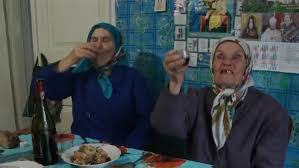Survival in Chernobyl’s Exclusion Zone
The Babushkas of Chernobyl
Al Jazeera (2016)
Film Review
To celebrate the 30th anniversary of the nuclear accident at Chernobyl, Al Jazeera has made this eye opening documentary about 100 elderly “babushkas” who defied authorities and returned to their farms in the Chernobyl exclusion zone. Most of these women live independently, surviving off subsistence farming. However they meet up for birthdays and other celebrations, to sing and down plenty of vodka.
Formerly they all received pension checks from the Ukrainian government – delivery has become less reliable with the recent civil war.
Aside from the “babushkas,” a number of researchers, soldiers and administrators work in the exclusion zone. For health reasons, they are limited to 15 days a month and forbidden to eat food or drink water from the exclusion zone. Both are contaminated with radioactive cesium, which is absorbed into muscle, and strontium, which is absorbed into bone. People are also discouraged from entering the exclusion zone in the presence of heavy winds – dust containing uranium and plutonium can be deadly when inhaled.
The “babushkas,” who are irresistible research subjects, are visited regularly by Ukrainian soldiers, who measure the amount of radiation in their cottages, water and foodstuffs. One of them developed thyroid cancer from radioactive iodine, the first radionucleotide released during a nuclear explosion. Since her thyroid was removed in 1986, her health has been fine.
The video can’t be embedded but can be viewed free at


The Most Revolutionary Act
- Stuart Jeanne Bramhall's profile
- 11 followers




